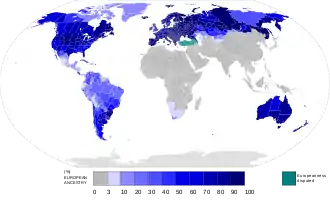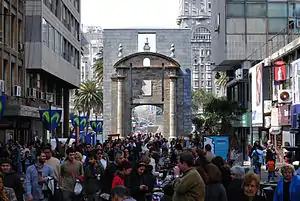Immigration to Uruguay
Immigration to Uruguay started with the arrival of Spanish settlers during the Colonial Period to what was then known as Banda Oriental. The immigration to Uruguay is very similar, if not the same, towards the Immigration to Argentina. Throughout history, Uruguay is known to gain massive waves of immigration all around the world, specifically European immigration, where today 90-95% of the Uruguayan population contains a European background. The climax of these immigration movements occurred during World War I and World War II, where the whole European continent was in a very unsettling position. The most highlighted group of immigrants in Uruguay are the Spaniards and Italians, both establishing the backbone of modern day Uruguayan culture and society.
Overview
Uruguay is a multiethnic nation formed by the combination of different groups over five centuries. Amerindians inhabited Uruguayan territory for several millennia before Spanish Conquest in the 16th century. Spaniards and Africans arrived in significant numbers under colonial rule. Many people of European background, African background and some Amerindians.[1]
Beginning in the second half of the 19th century, there has been a gradual European immigration from several countries, which had its peak between 1870 and 1920; back then, Villa del Cerro neighbourhood in Montevideo was characteristically populated by immigrants.[2]
In April 1831, government troops massacred most of the Amerindian population under the command of General Fructuoso Rivera, this is remembered as the Matanza del Salsipuedes.
Main immigration groups

Spaniards, Italians, and descendants of African slaves together formed the backbone of modern day Uruguayan culture and society.
Minor immigrant groups that, although are small in number, still play an important role in Uruguayan society, include:
- French: Making 10% of Uruguay's population (c. 300,000), Frenchmen began immigrating to South America during the 1800s. French Uruguayans are the third largest ancestry group in Uruguay, behind Spaniards and Italians. Ever since French immigrants entered Uruguay, French influence has always been strong in Uruguayan culture.
- Germans: Uruguay does contain a number of Germans: about 10,000 German expatriates and 40,000 people of German descent. Uruguay has also adopted some of Germany's culture, and a variety of German institutions.
- Jews: Uruguay has about 12,000-20,000 Jews, and even though it isn't a large number, it's one of the biggest Jewish communities in the world, and one of the biggest religions in Uruguay. The majority of Jews entered during World War I and World War II, the most being Ashkenazi Jews, German Jews, and Italian Jews.
- Lebanese: There are about 53,000-70,000 Lebanese in Uruguay; it is one of the oldest immigrant groups in South America, dating the first wave back around the 1860s.
- Other significant minorities include: Armenians, Austrians, Basque, Britons, Bulgarians, Croats, Greeks, Hungarians, Irish, Scots, Syrians, Lithuanians, Poles, Russians, Romani, Slovaks, Slovenes, Swiss, Ukrainians. There are very small Asian communities, mainly from China, Japan and Korea.[1]
There is a very recent inflow of Latin Americans: Peruvians, Bolivians, Paraguayans, Venezuelans. The University of the Republic is free, which means that several Chilean students come to study in Uruguay. Many people from neighboring Argentina and Brazil, who frequently travel to Uruguay to spend their holidays, have chosen it as permanent residence. In a very recent trend, North Americans and Europeans also choose Uruguay to retire. There are over 12,000 foreign workers from 81 countries registered in the Uruguayan social security.[3]
Immigrants tend to integrate in mainstream society, as several scholars have shown.[4]
Based on data from the 2011 census, currently there are about 77,000 immigrants in Uruguay and 27,000 returning Uruguayans.[5]
As of October 2014, Uruguay received a new immigration flow of Syrian people as a consequence of the Syrian Civil War.[6]
During the last years Uruguay has been experiencing the drama of stateless people.[7] The Government has plans to diversify the reasons for obtaining visas in order to adapt to the new reality.[8]
Children
About 1.3% of schoolchildren are foreigners, mostly from Brazil, Argentina, Spain, Venezuela, and the USA. A total of 62 countries are represented in Uruguayan schools.[9]
See also
Bibliography
- Goebel, Michael. "Gauchos, Gringos and Gallegos: The Assimilation of Italian and Spanish Immigrants in the Making of Modern Uruguay 1880–1930," Past and Present (August 2010) 208(1): 191-229 doi:10.1093/pastj/gtp037
- Bresciano, Juan Andrés. "L'Immigrazione Italiana in Uruguay Nella Piu Recente Storiografia (1990-2005)." ["Italian immigration to Uruguay in the most recent historiography, 1990-2005"] Studi Emigrazione, June 2008, Vol. 45 Issue 170, pp 287–299
References
- Felipe Arocena. "The contribution of immigrants to Uruguay" (PDF). Multiculturalismoenuruguay.com. Archived from the original (PDF) on 4 March 2016. Retrieved 21 October 2013. (in Spanish)
- Manuel Esmoris. "Villa del Cerro, identity and fracture" (PDF). Gestioncultural.com.uy. Archived from the original (PDF) on October 29, 2013. Retrieved 24 October 2013. (in Spanish)
- "Foreign workers in Uruguay". EL PAIS. Retrieved 4 November 2013. (in Spanish)
- Renzo Pi Hugarte. "La asimilación cultural de los siriolibaneses y sus descendientes en Uruguay" (PDF). Retrieved 2 February 2015. (in Spanish)
- "Uruguay has 77,000 immigrants". Montevideo.comm. 17 June 2013. (in Spanish)
- "Uruguayan resettlement scheme offers Syrian refugees a lifeline". The Guardian. 27 August 2014.
- "Stateless phantoms in Uruguay". EL PAIS. 6 June 2015. (in Spanish)
- "Gobierno estudia incorporar nuevos tipos de visa". El Observador. 27 April 2018. (in Spanish)
- "Children from 62 countries at Uruguayan schools". EL PAIS. 29 August 2018. (in Spanish)
| Wikimedia Commons has media related to Immigration in Uruguay. |

